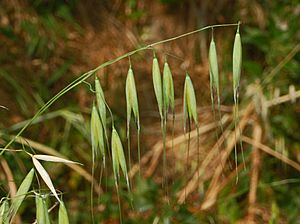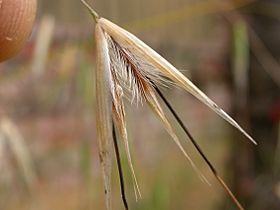Slender wild oat facts for kids
Quick facts for kids Slender wild oat |
|
|---|---|
 |
|
| Scientific classification | |
| Genus: |
Avena
|
| Species: |
barbata
|
| Synonyms | |
|
Avena hirsuta |
|
Avena barbata is a type of wild oat often called the slender wild oat. It is a kind of grass that grows every year, mostly in winter. You can even eat its seeds!
This plant is special because it has four sets of chromosomes, which is unusual for a plant. It grew from two older types of wild oats, A. hirtula and A. wiestii. These two types are found in the Mediterranean area and in deserts. They are so similar to A. barbata that it's hard to tell them apart when they grow together.
Contents
What Does Slender Wild Oat Look Like?
This grass grows thin stems, called tillers. They can reach about 60 to 80 centimeters tall, but sometimes even taller. The plant has bristly seed heads, known as spikelets, which are 2 to 3 centimeters long. Each spikelet has a bent, hair-like part called an awn that can be up to 4 centimeters long.
How Slender Wild Oat Reproduces
Avena barbata mostly reproduces by itself. This means it doesn't need pollen from another plant to make seeds. It's like the plant is its own parent! Only a very small amount of the time does it mix its genes with other plants.
Where Slender Wild Oat Grows
Slender wild oat is originally from Central Asia, as far east as Pakistan, and the Mediterranean Basin. But it has spread to many other places around the world.
Slender Wild Oat Around the World
You can find it in places with climates similar to the Mediterranean, like New Zealand, Australia, South Africa, Argentina, Chile, Brazil, and Uruguay. In Europe, it has been seen in Finland, France, Germany, Norway, Bulgaria, and Austria.
Slender Wild Oat in North America
In North America, Avena barbata is an introduced species. This means it was brought there by people, not that it grew there naturally. It is also considered a noxious weed because it can take over areas. It is very common in California, where it has replaced some of the native grasses. You can also find it in Oregon, Washington, Hawaii, Massachusetts, Nevada, Arizona, and New Mexico.
Scientists believe that the Avena barbata found in Argentina and California originally came from Spain. This happened during the time of the Spanish colonization of the Americas.
Studying Slender Wild Oat in California
Scientists have studied Avena barbata in California a lot. They wanted to understand how different types of this plant adapted to different environments. These different types are sometimes called "ecotypes."
Different Types of Slender Wild Oat
For many years, researchers at U.C. Davis and Dalhousie University studied the genes and features of these plants. They found two main types in California:
- The xeric type grows in drier areas, like the Central Valley. These plants usually have dark, hairy seeds and smooth leaves.
- The mesic type grows in wetter areas, like along the coast or in the mountains. These plants often have white seeds and hairy leaves, or a mix of features.
These two types also look different in other ways. The mesic type is generally bigger and makes more seeds. The xeric type has smaller main leaves. Scientists found that the xeric type had less genetic variety than the mesic type. This means the xeric plants were more alike to each other.
Identifying the Types
To tell the xeric and mesic types apart in the field, you can look at:
- How hairy the base of their leaves are when they are young.
- The color of their seeds when they are ripe.
- The size of their main leaves.
Environment and Plant Types
Scientists thought that the different types of Avena barbata were linked to how much rain and what temperature an area had. The xeric type was found in places with less rain (250mm to 500mm). The mesic type was found in areas with more rain (over 500mm).
However, experiments in greenhouses didn't show that the xeric type was better at growing in dry conditions. Some scientists even think the mesic type might be stronger and could be taking over areas where the xeric type used to be common, especially in Northern California.
Studying Slender Wild Oat in the Mediterranean
Scientists also studied Avena barbata in Spain, Israel, and Morocco. They found that the plants in the Mediterranean have more genetic differences than those in California. Also, the specific genetic combinations found in California are unique to California. The Mediterranean plants have their own unique genetic combinations. For example, a special genetic type is found only in the colder parts of Spain.
The "xeric" and "mesic" types found in California are not found in Spain.
Studying Slender Wild Oat in Argentina
The Avena barbata plants in both California and Argentina have less genetic variety than those in Spain. This suggests they came from Spain.
However, Argentina has a very common genetic type called the "Pampeano" type, which is not found in Spain. This "Pampeano" type is different from California's "xeric" type. The "xeric" type from California is found in a small number of plants in Argentina and also in Chile.
All the genetic evidence points to Avena barbata arriving in both Argentina and California from southwest Spain.
Images for kids
See also
 In Spanish: Avena loca para niños
In Spanish: Avena loca para niños


